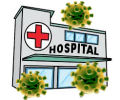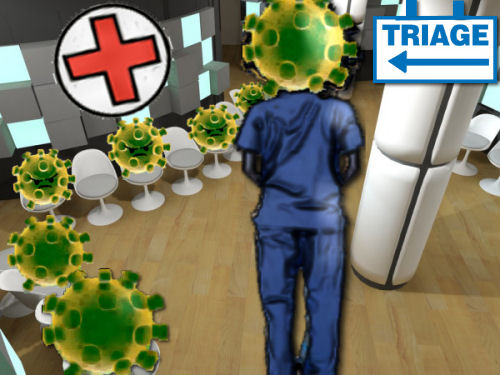 Who in earth designed this VHIMS system and why haven't they been sent to prison? How many people have suffered by this? The Victorian Health Department relies on this evil joke of a system: http://www.health.vic.gov.au/clinrisk/vhims/ The policy of promotions by 'merit' somehow finishes up keeping anyone intelligent or principled out of executive jobs in this field. I have actually used the VHIMS system and the absolute failure of management to care that it made things worse contributed to my growing sense of danger and injustice. The attitude to safety and the law in public hospitals is absurd - no better than in Florence Nightingale's time. Hospital managers are reckless; they are laws unto themselves. Inside excerpt from Auditor General's shocking report on Victoria's hospitals.
Who in earth designed this VHIMS system and why haven't they been sent to prison? How many people have suffered by this? The Victorian Health Department relies on this evil joke of a system: http://www.health.vic.gov.au/clinrisk/vhims/ The policy of promotions by 'merit' somehow finishes up keeping anyone intelligent or principled out of executive jobs in this field. I have actually used the VHIMS system and the absolute failure of management to care that it made things worse contributed to my growing sense of danger and injustice. The attitude to safety and the law in public hospitals is absurd - no better than in Florence Nightingale's time. Hospital managers are reckless; they are laws unto themselves. Inside excerpt from Auditor General's shocking report on Victoria's hospitals.
Auditor General exposes dangerous, dysfunctional hospital reporting system which seems designed to cover up, not collate
In the Auditor General's report:
3.4 Incident reporting system [1]
"The incident reporting system used by public hospitals in Victoria is called the Victorian Health Incident Management System (VHIMS) and is licensed to the Department of Health (the department). Incident reporting is a key element of a safety management system. Over 2 500 OHS incidents were reported annually by around 16 000 employees of the four publ ic hospitals visited.
During the site visits, VHIMS was found to be not fit-for-purpose as an OHS incident reporting system. It does not enable, as the Department of Human Services-Public Hospital Sector Occupational Health and Safety Management Framework Model (OHS Management Framework) states, 'a formal process by which accidents, incidents, near misses or potentially unsafe si tuations are reported to people with the responsibility to investigate and institute any required corrective ac tions'. Issues with the VHIMS system include:
- Some mandatory fields-such as whether the OHS incident was disclosed to visitors of patients-are of no relevance to OHS incidents as they are designed for clinical incidents. Repeatedly filling in irrelevant fields makes reporting unnecessarily time consuming, which can deter staff from reporting minor incidents and near misses.
- There are no fields to capture vital OHS information, such as:
- signs and triggers leadi ng to frequent occupational violence incidents-for example, assaults-which carry t he most severe consequences for public hospital staff x OHS training of the staff mem ber who reported the OHS incident.
- Staff interviews and site visits showed that categories to cla ssify OHS incidents are complicated, unclear, too numerous-124 to choose from-and sometimes irrelevant or overlapping.
For example, occupat ional violence can be classified as 'inappropriate contact' or 'physical aggres sion'. This limits the usefulness of aggregated management reports, and hinders accurate and consistent input by the reporting staff member.
- - The incident severity rating is also of questionable value as it:
- is based on clinical risk and is inappropriate for OHS incidents. For example, a patient needing medical attention as a consequence of a patient safety incident is rightly seen as significant and is assigned a high severity rating. On the other hand, staff needing medical attention after an OHS incident may not necessarily be given such a high rating.
- Does not capture probable consequences if the incident occurred again, or the likelihood of a repeat occurrence. A near miss arising from faulty equipment could have much graver c onsequences next time.
-
Interviewed staff report - and site visits confirm - that training in the incident reporting system is inadequate, with brief overviews given during staff induction and no follow-up training offered at any of the public hospitals visited. The system complexity requires a more in-depth approach, particularly for work ers who may not be computer proficient.
Of the 42 staff interviewed, 36 reported that the incident reporting system was not user friendly. All 16 OHS directors surveyed stated that they believe there is under-reporting of both OHS incidents and near misses.
Code blacks are called in public hospital s when staff are physically threatened, and each is recorded in a security log. Comparison at one public hospital between this log and occupational violence incidents in VHIMS found that 70 per cent of incidents where staff were physically threatened and a code black was called were not reported in VHIMS.
This is a systemic and longstanding issue, as both the 2005 Victorian taskforce on violence in nursing report and the 2011 Parliamentary Inquiry into Violence and Security Arrangements in Victorian Hospitals and, in particular, Emergency Departments found that the incident reporting system was difficult for staff to use, and that under-reporting of OHS incidents was a significant issue.
Reporting was also not timely, which means that staff may be exposed to an OHS risk several times before control measures can be put into place or management is aware of the hazard. At one site, 87 per cent of OHS incidents were not entered into VHIMS within seven days of the incident occurring. No reason was given for this, although staff report that entering an OH S incident into VHIMS often has to wait until a shift is finished or a computer is available.
The VHIMS used by hospitals has been designed to capture clinical patient safety incidents and has not been appropriately modified to readily capture OHS incidents.
This undermines the stated departmental VHIM S project objective to 'develop a statewide, standard methodology, for the wa y incident information is reported within publicly-funded health services'. Figure 3A illustrates shortcomings in VHIMS for one particular OHS risk - occupational violence."[1]
Hospital management culture a danger to public
After more than a decade working in one major hospital in Victoria, I came to the conclusion that management were on a power-trip and had completely lost touch with what hospitals are there for - to help seriously unwell people get better.
It seems that being able to rapidly fire orders downwards to an army of professionals and skilled workers who rely utterly on references from management and cannot answer back simply goes to the heads of those in charge.
The experience of many nurses is of a sadistic, self-indulgent management that employs specialist human-resources professionals to help them silence the complaints of their victims. Tools like the VHIMS are made to order for these bullies. Victoria's industrial laws are close to useless and health sector unions seem to be in league with hospital management. Thanks are due to the Auditor General for validating the perception of those who toil below decks in these whitewashed over-insured laughably credentialed concentration camps. There should be mass-sacking of Victorian Hospital Management, notably the CEOs of the four hospitals examined and their salaries should be redistributed to the lowest paid workers in those places.
NOTES
Source:
 I was talking to a nursing friend who works in a large suburban Melbourne hospital emergency department, triaging patients for a particular area. I will call her Angie.
I was talking to a nursing friend who works in a large suburban Melbourne hospital emergency department, triaging patients for a particular area. I will call her Angie.

 Who in earth designed this VHIMS system and why haven't they been sent to prison? How many people have suffered by this? The Victorian Health Department relies on this evil joke of a system:
Who in earth designed this VHIMS system and why haven't they been sent to prison? How many people have suffered by this? The Victorian Health Department relies on this evil joke of a system:
Recent comments